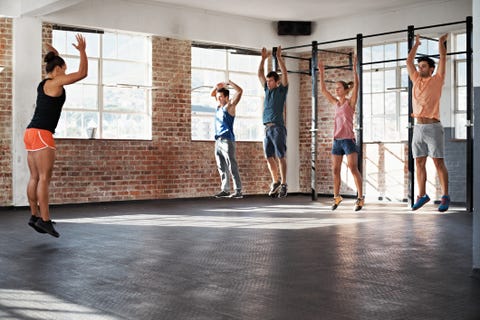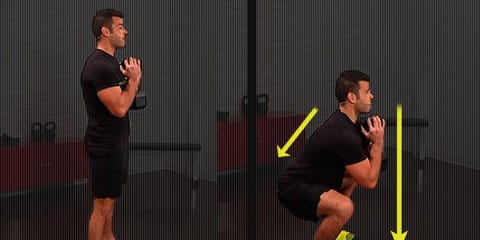A young man doing leg exercises once told me that squats hurt his knees. So I asked him to demonstrate a squat. He tucked his head into his chest like a turtle, brought his knees toward each other, and bowed forward. I told him, “Squats don’t hurt your knees; what you’re doing hurts your knees.”
As a national masters champion weight lifter and someone who’s been doing this leg exercise since the Johnson administration, I’ve heard all the arguments against squats, such as how they’re bad for your knees and back.
And I’ve seen many men prove those accusations right by butchering the move.

Any properly executed squat, however, may be a more effective muscle builder than all other exercises combined. It requires the synchronized recruitment of muscle fibers throughout your body.
And because squatting is one of the most natural human movements, like walking or using the remote, it’s perfectly safe. Research shows that squats burn up to three times as many calories as previously thought. So this type of leg exercise is a powerful fat-burning tool as well.
Ready to carve rock-solid muscle and harness whole-body strength, power, and athleticism? Use the plan that follows. It’s simple, and I’ve used it with thousands of athletes—so I know that it works.
1. Squat with Your Elbows

First, do three consecutive vertical jumps, then look down. This is roughly where you want to place your feet every time you squat.
Set your feet and bend your hips and knees to lower your body as far as you can. Then, when you’re in your deepest position, push your knees out with your elbows. Try to keep your feet flat on the floor and allow your butt to sink below knee height.
Relax in this position for two or three seconds, then descend a bit deeper and drive your knees out with your elbows once more.
For most men, this small elbow maneuver will simplify squatting forever, because it makes you drop your torso between your thighs rather than fold at the waist.
Stand up, and go to step two.
2. Do the Doorknob Drill

Getty ImagesLuca Mason / EyeEm
You may think of the squat as a lower-body exercise, but proper upper-body alignment is essential. Perfect your posture with this drill.
Stand an arm’s length away from a doorknob and grab the handle with both hands. Set your feet as you did in step one.
Now lift your chest, which in turn will tighten your lower back. Your latissimus dorsi muscles will naturally spread a bit and your shoulders will move back slightly.
Holding the doorknob, and keeping your chest up and arms straight, bend your hips and knees to lower your body, and lean back. Then stand up.
By staying tight through your chest, shoulders, and core muscles, you distribute weight more evenly throughout your body. As a result, you’ll be able to handle greater loads with less risk of injury.
3. Behold the Goblet Squat
Named for the way in which you hold the weight—in front of your chest, with your hands cupped—the goblet squat may in fact be the only squat you need in your workout.
Start with a light dumbbell, between 25 and 50 lbs., and hold it vertically by one end. Hug it tight against your chest.
With your elbows pointing down, lower your body into a squat. Allow your elbows to brush past the insides of your knees as you descend. It’s okay to push your knees out.

Return to a standing position. Your upper body should hardly move if you’re using your legs, hips, and lower back as a unit.
Don’t worry if this isn’t perfect the first time. Most men mess up when they think about the move. Just let your elbows glide down by rubbing past your knees, and good things will happen.
The Triple Digit Goblet Squat Workout
Throw down a 100 lb. goblet squat in just six weeks using this plan.
Once you’re able to bang out a few sets of 10 with triple-digit weight, you’ll realize the full-body benefits of squats.
Weeks 1 and 2
Hone your technique. Five days a week, perform two to three sets of five to 20 repetitions of goblet squats. Use a light dumbbell, or even a heavy book.
Week 3
Do squats three days a week, resting for at least a day between sessions. You’ll improve your technique and increase strength and muscle endurance.
Day 1 Perform a “rack walk-up.” Grab the lightest dumbbell you can find and do a set of five goblet squats. Return the weight to the rack and grab the next heaviest dumbbell.
The exchange should take you no more than 20 seconds. Do another set, then continue moving up the rack until you find a dumbbell that’s challenging to lift but still allows perfect technique.
Day 2 Do the reverse of Day 1: a “rack walk-down.” Start with your second-heaviest dumbbell from Day 1, and complete a set of five reps.
Move down the rack, lifting a lighter weight for each set of five. Aim for a total of 10 to 12 sets, resting for no more than 20 seconds between sets.
Day 3 Combine your workouts from Day 1 and Day 2. You’ll start by moving up in weight, performing sets of five repetitions.
When you reach your heaviest weight, work back down the rack. Rest for two days before your next squat workout.
Week 4
Same as Week 3, but perform three reps with each dumbbell, using heavier weights than in your last workout.
Week 5
By now you should feel comfortable performing the goblet squat. You’ll focus on building muscle and strength. Again, rest for at least a day between workouts.
Day 1 Do two sets of 20 repetitions using a dumbbell that challenges you in the last five reps. Rest for two minutes between sets.
Day 2 Choose a weight that makes it difficult to complete 10 reps. Do three sets of eight reps, resting 60 seconds between sets.
Day 3 Perform a rack walk-up. Do three reps with each weight, and stop when you feel your technique beginning to falter.
Week 6
This week’s theme is simple: If you can pick it up, you can squat it.
Day 1 Do the regular rack walk-down, performing three reps per set with a heavy weight. Then do it again, this time starting with a slightly heavier dumbbell. Rest for no more than 20 seconds between sets and for 30 seconds between walk-downs.
Day 2 Do a couple of light warm-up sets of goblet squats, then do the rack walk-up twice. Do three reps per set and rest for up to 30 seconds between sets.
Day 3 Do a few easy sets to warm up. Then find the heaviest dumbbell you can lift–aim for three digits–and perform the goblet squat.
Source: Read Full Article
